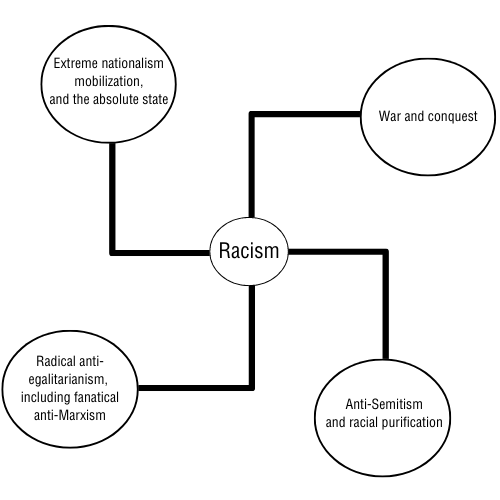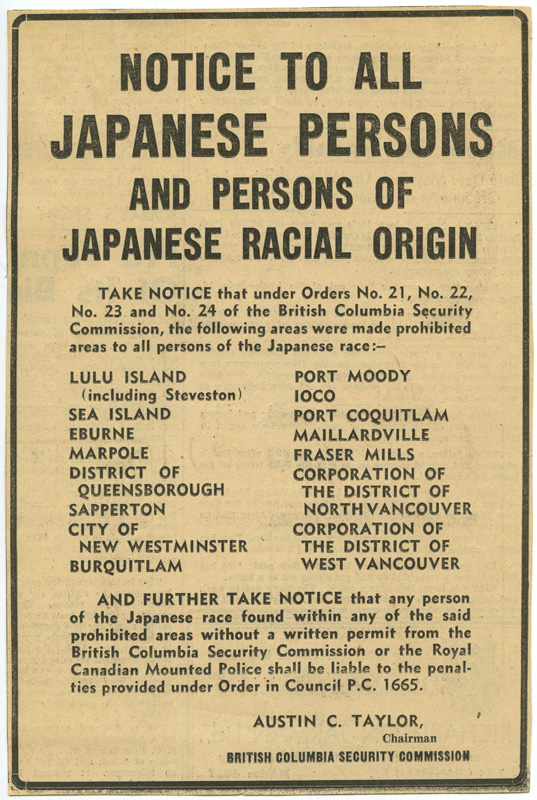10.2 Variants of Fascism: Nazism
Gregory Millard
If Mussolini’s Italy represents the “standard” form of fascism, Nazi Germany can be seen as the most important variant of this ideology (e.g., Bosworth, 2009). Tomasz Ceran describes Nazism as an “ideological swastika” (Ceran, 2015, pp. 14-26) with racism at its centre. We can freely adapt his metaphor as follows:

The ideas seen in the four corners of this swastika are all infused with, and shaped by, the racism at its core. “The racial question gives the key not only to world history, but to all human culture,” Hitler claimed. And in this view, the Aryan race is superior to all others: per Hitler, “all the human culture, all the results of art, science, and technology that we see before us today, are almost exclusively the creative product of the Aryan [race].” This race once ruled the world, Nazis postulated, but it lost its position due to “blood-poisoning” (i.e., mixed blood). Nazis imagined a racial hierarchy descending downward from Western Europeans to Asians, to Africans, and finally to groups designated as “subhuman” (Jews and Romany). A fanatical anti-Semite, Hitler blamed Jews and “Judification” for the German defeat in the First World War, for the evils of Bolshevism, and, in essence, everything that ailed a struggling Germany (Kershaw, 2014).
Where Mussolini suggested that the nation was a product of the state (Mussolini, 1932, p. 2), for the Nazi variant of fascism, “the state should be synonymous with the nation, synonymous with the race” (Ceran, 2015, p. 16). The Nazi project of national rebirth involved the same kind of mass mobilization and absolute state described earlier, but for Nazis, national rebirth meant racial rebirth, and the quest for internal purity therefore entailed racial purification.
This racist vision also informed Nazism’s external face. “The Nordic race has the right to rule the world and we need to make this right of race the guiding star of our foreign policy,” Hitler declared (Ceran, 2015, p. 14). Nazis asserted that the Aryan race needed “living space,” i.e., territory and resources well beyond those claimed by Germany after 1918. Human progress and civilization required the Aryans, via the German state, to exert “the supremacy of the superior Race over the entire world” (cited in Spielvogel and Redles, n.d.). Informed by such racism, warfare was baked into Nazism, as it was in mainline fascism.
Nazi Germany thus embarked upon an interlocked program of racial purification and military expansion. As we saw earlier, Nazi Germany conquered almost all of Europe. Both domestically and in its conquered satellites, the Nazis committed many atrocities against Jews, Slavs, Romany, and other targets. Measures included kidnapping around 200,000 children of Polish and other ethnicities and placing them in “good” German homes, as well as the forced sterilization of criminals, LGBTQ+ persons, and persons with disabilities (“more than 1% of the total German population was sterilized” Gwiazda II, 2014, p. 47). The apex of these horrors was the program of genocide known as the “Final Solution,” later labelled the Holocaust. Initially, the Nazis segregated Jews, stripping them of citizenship, requiring them to publicly identify themselves so as to be distinguished from non-Jews, and herding them into ghettos. After considering deporting Jews to other parts of Europe, the Nazis instead decided to pursue mass extermination on a gargantuan scale. In this final phase, Jews throughout Nazi-occupied Europe were shipped to extermination camps, along with Slavs, Romany, and other targets. Upwards of six million people were murdered (incinerated, shot, or gassed) or else died of the inhuman conditions in these camps (e.g., Paxton, 2005, pp. 158-64).
Italian fascism was less fervently racist in its conception of nationhood, though Mussolini’s government was certainly racist (as was, it must be said, much of the western world). Nazi racial assumptions were not at the centre of the Italian fascist program. Nevertheless, Italy, along with other Axis countries, imposed anti-Semitic legislation under Germany’s influence and participated in the Holocaust. Indeed, contemporary scholarship is unequivocal that Mussolini’s Italy mutated over time into a robustly racist and anti-Semitic regime (Bosworth, 2009, pp. 306-311).
Canada and the Holocaust

Hundreds of Jewish refugees fled the depredations of Nazi Germany and sought refuge in Canada – only to be turned back by exclusionary Canadian policy. Canada also committed massive human rights violations by dispossessing and interring those it designated “enemy aliens” (mostly Jewish refugees and Japanese Canadians) in prison camps during the Second World War. Conversely, Canada was an important part of the alliance that defeated the Axis Powers in the war, helped liberate concentration camp prisoners, and took in 40,000 Holocaust survivors in the aftermath.
Media Attributions
- Ideological Swastika © Alexandra Taylor is licensed under a CC BY-NC (Attribution NonCommercial) license
- Notice to all Japanese Persons and Persons of Japanese Racial Origin – British Columbia Security Commission Japanese internment notice (1942) © British Columbia Security Commission is licensed under a Public Domain license

